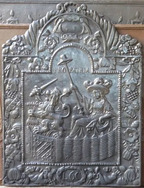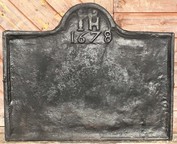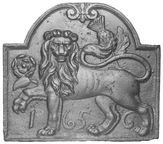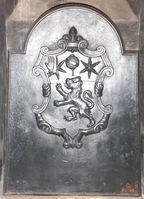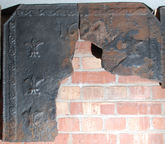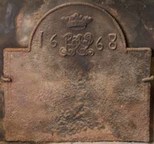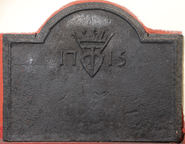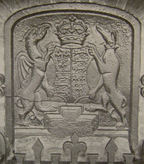-
1212
Description: Arched rectangular central panel with bead edging; wickerwork Garden of Holland (Hollandse Tuin) within which is seated a berobed female figure holding a cap of freedom on the end of a long pole; before her is the crowned heraldic lion of the States General of the Netherlands, clutching a sheaf of arrows in its left front paw; above are the words, Pro Patria; arched rectangular border with fillet edging; central cartouche at top, with festoons of fruit, flowers and leaves suspended on each side from ribbons supported by rings; at the bottom, swirled ribbon around an oval compartment bearing the inscription 'L6C'; on top, a central cartouche from which descend a cornucopia on each side of the arch.
Notes: An overtly patriotic theme with symbols of Dutch nationhood; the inscription at the bottom indicates the style of border; other firebacks with the same inscription have the same border; similar inscriptions (e.g. L7C and L8G) indicate different borders.
Inscription: PRO PATRIA / L6C
- Decoration tags:
- 'Dutch' (shape)
- fillet (edging)
- whole carved pattern
- pictorial
- allegorical
- text
- animals
- humans
- plants
- objects
Manufactured: in the late 17th century in the Siegerland area of Germany.
Current location: 21 Nederstraat, Amerongen, Utrechtse Heuvelrug, Netherlands.
- Attached to series:
- 'Dutch' LC/G series
- 'Dutch' Garden of Holland firebacks
-
603
Description: Arched rectangular shaped, the arch linked to the rectangle by cavetto curves; cavetto edging ending in two opposed spirals at top; initials below spirals; date below initials; otherwise plain.
Notes: Probably cast from a carved, edged board, with the initials and date added separately. A copy.
Copies of this fireback are known.
Inscription: IH / 1678
- Decoration tags:
- cavetto arched rectangular (shape)
- cavetto (edging)
- individual letters
- individual numbers
- text
Manufactured: in 1678 in the Weald area of England.
Current location: Banbury, Oxfordshire, England.
- Attached to series:
- Small arch series
- Date & initials firebacks
-
399
Description: Arched rectangular shape; ovolo-moulded edging with inverted fleur-de-lys at top; lion passant guardant, with rose to the left and thistle above tail; date split between legs; single horizontal plank-line.
Notes: The boldness of the figuration suggests association with firebacks possibly cast at Brede Furnace in the same period.
Copies of this fireback are known.
Inscription: 1 6 5 6
- Decoration tags:
- arched rectangular (shape)
- cyma reversa/ogee (edging)
- whole carved pattern
- planklines
- heraldic
- text
- animals
- plants
Manufactured: in 1656 in the Weald area of England.
Current location:, not known.
- Attached to series:
- Royalist series
-
814
Description: Inclined arched rectangular shape' bevelled fillet edging; cartouche shield of the arms of the baronetcy of Dryden of Canons Ashby.
Arms: Dryden family, probably Sir Henry Edward Leigh Dryden Bt.
- Decoration tags:
- inclined arched rectangular (shape)
- bevelled fillet (edging)
- whole carved pattern
- armorial
Manufactured: in the late 19th century in England.
Current location: Canons Ashby, Canons Ashby, Northamptonshire, England.
Museum number: NT/L/CAN/M/78 (part of the National Trust museum group)
- Attached to series:
- Personal armorial firebacks
-
235
Description: Fragment; canted rectangle; twisted rope edging (top and sides); repeated scroll strip stamp along each side; date, top centre; a fleur-de-lys stamp repeated three times vertically down left side, probably mirrored on right side (top fleur visible).
Notes: Use of the same stamps indicates a common source with a variant dated 1692 (see Fireback no. 237).
Inscription: 1694
- Decoration tags:
- canted rectangular (shape)
- rope (edging)
- simple stamps
- carved stamps
- individual numbers
- heraldic
- text
- objects
Manufactured: in 1694 possibly in the South Wales area of Wales.
Current location: National History Museum, St Fagans, Glamorgan, Wales.
Museum number: 61.49/3 (part of the Welsh National History Museum museum group)
- Attached to series:
- St Fagans series
- Date only firebacks
-
1179
Description: Arched rectangular shape; astragal and fillet edging (top and sides); central shield with arms of Eton College, surmounted by a small tilting shield of the pre-1603 Royal arms of England (France modern quartering England) aslant beneath a crown; to each side a spray of lilies; below, a scroll bearing the motto - Esto Perpetua; bottom left the date MCMXCII; bottom right, a panel bearing the phrase C of A and [?].
Notes: The motto Esto Perpetua means Let it be perpetual. Fireback designed by and made for Martin, Lord Charteris of Armisfield, who was Provost of Eton College 1978-91. One of a set of two cast for the college.
Copies of this fireback are known.
Inscription: ESTO PERPETUA / MCMXCII C of A [Charteris of Armisfield]
Arms: Eton College
- Decoration tags:
- arched rectangular (shape)
- astragal & fillet (edging)
- whole carved pattern
- heraldic
- armorial
- text
- plants
Manufactured: in 1992 in England.
Current location: Eton College, Eton, Berkshire, England.
Museum number: FDA-A.238:2-2013 (part of the Eton College museum group)
- Attached to series:
- Martin Charteris firebacks
- Corporate firebacks
-
1225
Description: Arched rectangular shape; twisted rope edging (top and sides); in arch, marquess's coronet above a monogram with date split either side.
Notes: The elaborate monogram has not been deciphered, but the fireback does not appear to be related to the Talbot family who owned Lacock throughout the 17th century.
Inscription: 16 [undeciphered monogram] 68
- Decoration tags:
- arched rectangular (shape)
- rope (edging)
- whole carved pattern
- individual numbers
- heraldic
- monogram
- text
Manufactured: in 1668 in England.
Current location: Lackock Abbey, Lacock, Wiltshire, England.
Museum number: 996713 (part of the National Trust museum group)
- Attached to series:
- Miscellaneous pattern firebacks
-
363
Description: Arched rectangular shaped, the arch linked to the rectangle by cavetto curves; cavetto edging ending in two opposed spirals at top; initials below spirals; date below initials; otherwise plain.
Notes: Probably cast from a carved, edged board, with the initials and date added separately.
Inscription: I or F H / 1698
- Decoration tags:
- arched rectangular (shape)
- carved stamps
- individual letters
- individual numbers
- text
Manufactured: in 1698 in the Weald area of England.
Current location: Scotney Castle, Lamberhurst, Kent, England.
Museum number: 791911 (part of the National Trust museum group)
- Attached to series:
- Small arch series
- Date & initials firebacks
-
389
Description: Arched rectangular shape; plain edge with inset astragal on all sides; stylised buckle surmounted by an earl’s coronet between the two halves of the date.
Notes: The buckle is the badge of the Pelham family and the earl’s coronet may refer to the Earldom of Clare to which Thomas Pelham-Holles, 2nd Baron Pelham of Laughton was raised in 1714. The following year he was created Marquess of Clare and Duke of Newcastle-upon-Tyne. Formerly part of the J. H. Every collection.
Inscription: 17 15
- Decoration tags:
- arched rectangular (shape)
- flanged (edging)
- carved stamps
- individual numbers
- heraldic
- text
Manufactured: in 1715 in the Weald area of England.
Current location: Anne of Cleves House, Southover High Street, Lewes, East Sussex, England.
Museum number: 1944.24.084 (part of the Sussex Archaeological Society museum group)
- Attached to series:
- Pelham family firebacks
-
1286
Description: Low-arched shape within broad fillet edging; on a plain field a Tudor royal shield, quarterly France Modern and England, supported by a stylised dragon and greyhound and surmounted by a crown, all resting on a two-stepped compartment with cavetto- and astragal-moulded edging at the top.
Notes: Pastiche 'Tudor' design by George Shaw of Saddleworth, Lancashire, c.1850, possibly intended to be passed off as genuine Tudor. Examples are also to be found in Warkworth Castle and Cheetham's Library, Manchester, both with a leaf pattern on the edging and 'scales' on the dragon. Firebacks of the same armorial design within a different, arched rectangular, edging are known, an example being at Hever Castle, Kent.
Arms: Tudor royal
Manufactured: in the mid 19th century possibly in the Lancashire area of England.
Current location: Guildhall, Bore Street, Lichfield, Staffordshire, England.
- Attached to series:
- George Shaw series
- Tudor royal armorial firebacks
